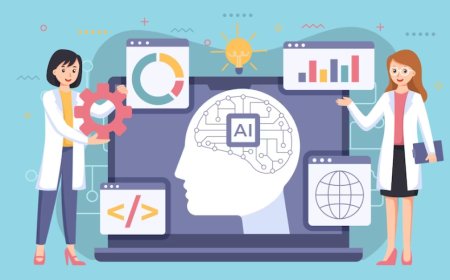Explore Machine Learning Mastery With Experts
Unlock the power of Machine Learning Mastery with expert insights, tutorials, and resources. Dive deep into ML algorithms, techniques, and applications for success

Machine Learning, at its core, is a transformative field of artificial intelligence that empowers computers to learn from data and improve their performance on tasks without being explicitly programmed. Its significance and wide-ranging applications span across industries, including healthcare, finance, autonomous vehicles, and recommendation systems, where it has revolutionized decision-making and problem-solving. Achieving mastery in Machine Learning is vital in this data-driven era, as it equips individuals and organizations with the capability to harness the power of data, make informed predictions, and drive innovation, ultimately shaping the future of technology and business.
Foundations of Machine Learning
The foundations of machine learning begin with a deep understanding of data. This understanding encompasses various aspects, such as recognizing different data types and formats and mastering the art of data preprocessing and cleaning. It's vital to grasp the intricacies of data, from its raw forms to its refined state.
Moreover, exploratory data analysis (EDA) plays a pivotal role. EDA involves utilizing data visualization techniques to gain insights into the dataset's patterns, trends, and anomalies. It also entails employing descriptive statistics to summarize key characteristics of the data, aiding in the initial assessment of its suitability for machine learning tasks. In essence, a strong foundation in understanding and working with data is the bedrock upon which successful machine learning endeavors are built.
Machine Learning Algorithms
A. Supervised Learning:
1. Regression:
Regression is a type of supervised learning used when the output variable is continuous or numerical. It aims to predict a real-valued output based on input features. For example, predicting house prices based on features like square footage, number of bedrooms, and location.
2. Classification:
Classification is another branch of supervised learning that deals with predicting a categorical or discrete output. In classification, the algorithm assigns data points to predefined categories or classes. Common applications include spam email detection, image classification, and disease diagnosis.
B. Unsupervised Learning:
1. Clustering:
Clustering is an unsupervised learning technique used for grouping similar data points together based on their inherent characteristics. It identifies patterns and structures in data without predefined labels. K-means clustering and hierarchical clustering are popular algorithms in this category.
2. Dimensionality Reduction:
Dimensionality reduction is the process of reducing the number of input variables or features in a dataset. It's commonly used to simplify complex data while retaining its essential information. Principal Component Analysis (PCA) and t-Distributed Stochastic Neighbor Embedding (t-SNE) are common dimensionality reduction methods.
C. Reinforcement Learning:
Reinforcement Learning (RL) is a type of machine learning where an agent interacts with an environment to achieve a specific goal. The agent takes actions to maximize a cumulative reward while learning from trial and error. RL has applications in game playing, robotics, autonomous vehicles, and optimizing decision-making in various domains.
D. Semi-Supervised Learning:
Semi-supervised learning is a hybrid approach that combines elements of both supervised and unsupervised learning. In semi-supervised learning, a model is trained on a dataset that contains both labeled and unlabeled examples. It leverages the limited labeled data along with the unlabeled data to improve learning accuracy and generalization. This approach is often used when obtaining labeled data is expensive or time-consuming.
E. Anomaly Detection:
Anomaly detection is the process of identifying abnormal or unusual data points within a dataset. Anomalies are data points that differ significantly from the majority of the data. This is valuable in various applications, such as fraud detection in finance, network intrusion detection, and equipment failure prediction. Anomaly detection algorithms aim to flag or classify these rare events.
These categories and subcategories represent the core techniques and approaches within the field of machine learning, each with its unique applications and methods. Understanding these categories is fundamental for anyone looking to navigate the world of machine learning effectively.
Model Evaluation and Metrics
-
Accuracy, Precision, Recall, and F1-Score are essential metrics used for evaluating the performance of machine learning models. Accuracy measures the proportion of correctly predicted instances, while precision assesses the ratio of true positive predictions within the positive predictions. Recall, on the other hand, gauges the proportion of true positives correctly identified. F1-Score is a balanced metric that combines precision and recall, providing a single measure of a model's accuracy.
-
The Confusion Matrix is a powerful tool that helps visualize the performance of classification models. It presents a table of true positive, true negative, false positive, and false negative predictions, enabling a deeper understanding of a model's strengths and weaknesses.
-
Cross-validation is a crucial technique used to assess a model's generalization performance. It involves dividing the dataset into subsets for training and testing multiple times, allowing the model to learn from different combinations of data. This helps identify potential issues like overfitting and ensures robust model evaluation.
-
Hyperparameter tuning involves optimizing a model's hyperparameters, such as learning rates and tree depths, to enhance its performance. This process is critical for finding the best configuration that maximizes a model's accuracy.
-
Overfitting and underfitting are common challenges in machine learning. Overfitting occurs when a model learns noise or irrelevant details in the training data, resulting in poor generalization to new data. Underfitting, on the other hand, happens when a model is too simple to capture the underlying patterns in the data. Striking the right balance between overfitting and underfitting is essential for building effective machine learning models.
Feature Engineering
In the realm of machine learning and data preprocessing, several critical tasks include feature selection, feature extraction, feature scaling, and handling missing data.
Feature selection involves choosing the most relevant input variables from a dataset, eliminating unnecessary or redundant features to enhance model performance and reduce complexity.
Feature extraction is the process of transforming raw data into a reduced-dimensional representation, often capturing essential patterns or characteristics while reducing computational demands.
Feature scaling ensures that the values of different features are on a similar scale, preventing some features from dominating others during the model's training.
Handling missing data is vital for addressing gaps or null values in datasets, as missing information can disrupt model training and predictions. Various techniques, such as imputation or removal, are employed to manage these data gaps effectively.
Together, these data preprocessing steps play a pivotal role in preparing datasets for machine learning tasks, contributing to the overall success and accuracy of the models applied to them.
Deep Learning
In the realm of machine learning, the journey into neural networks begins with an introduction, unraveling the foundations of artificial neurons and their interconnected layers. Delving deeper, one encounters the power of Deep Neural Networks, where complex patterns emerge through layers of computations, notably witnessed in Convolutional Neural Networks (CNNs) adept at image analysis and Recurrent Neural Networks (RNNs) specialized in sequence data. The concept of Transfer Learning emerges, where pre-trained models share knowledge across domains, optimizing training efficiency. Natural Language Processing (NLP) and deep learning converge to unlock the potential of understanding and generating human language, paving the way for chatbots, language translation, and sentiment analysis, among countless applications.
Tools and Libraries
Machine learning’s strong foundation begins with a proficiency in Python and its expansive machine learning ecosystem. Python's versatility, coupled with libraries like scikit-learn, TensorFlow, and PyTorch in category B, forms the backbone of machine learning development. These libraries provide the tools and frameworks for building, training, and deploying machine learning models across various domains. To streamline the development process and enhance collaboration, category C emphasizes the use of Jupyter notebooks and integrated development environments (IDEs). These tools enable data exploration, experimentation, and code documentation, ensuring a seamless workflow for aspiring machine learning practitioners and seasoned professionals alike.
Ethical Considerations in Machine Learning
Ethical considerations in machine learning encompass several critical aspects. Firstly, bias and fairness are essential concerns, as algorithms can inherit biases present in training data, potentially leading to discriminatory outcomes. Privacy concerns also loom large, with the need to safeguard individuals' sensitive information and protect against data breaches. Additionally, adhering to ethical AI principles is paramount, emphasizing transparency, accountability, and the responsible use of technology to ensure that machine learning systems benefit society while minimizing harm. These considerations collectively form the ethical foundation for the development and deployment of machine learning solutions.
Building a Machine Learning Portfolio
Building a strong presence in the field of machine learning involves a multi-faceted approach. Firstly, engaging in personal projects and participating in Kaggle competitions allows you to apply your skills, tackle real-world problems, and showcase your expertise. Secondly, maintaining a portfolio on platforms like GitHub, where you share your code and projects, enhances your visibility and credibility. Lastly, establishing an online presence through blogging, social media, and networking within the machine learning community helps you connect with peers, learn from others, and potentially open up opportunities for collaboration and career advancement. These three elements - personal projects, GitHub repositories, and online presence - collectively contribute to a well-rounded machine learning journey.
Machine Learning Mastery is paramount in today's data-driven world, as it empowers individuals and organizations to harness the potential of data for informed decision-making, automation, and innovation. Achieving mastery in this field opens doors to a myriad of opportunities, from solving complex problems to creating cutting-edge technologies. It's a journey that not only enhances your skills but also enables you to contribute meaningfully to diverse industries. As you embark on this learning path, remember that the landscape of machine learning is ever-evolving, with new challenges and breakthroughs awaiting those who delve deeper. So, stay curious, keep learning, and embrace the exciting journey of continuous discovery and innovation in the realm of machine learning.





































